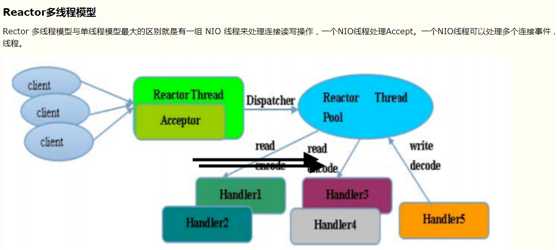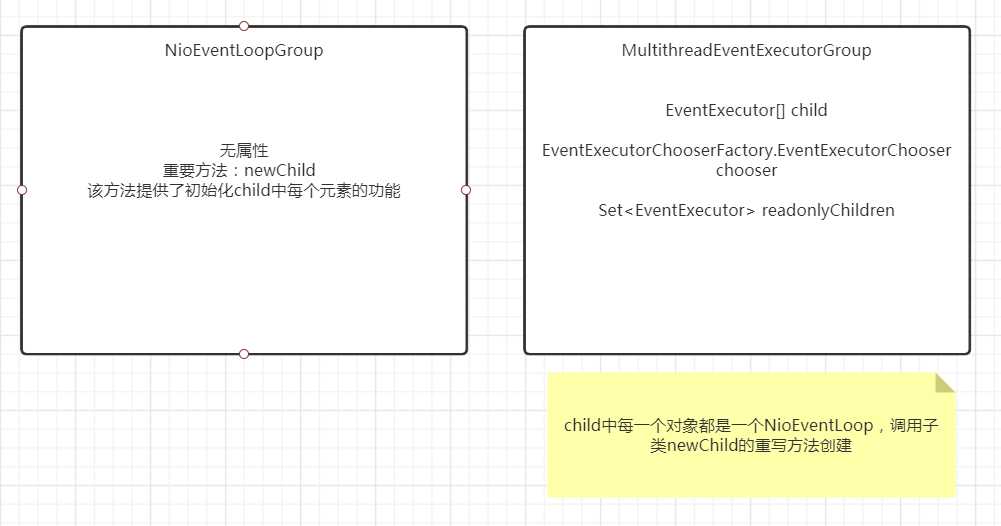Netty源码学习系列之1-NioEventLoopGroup的初始化
2021-02-13 01:15
标签:idt 方便 rtu form 注释 listen 串行 队列 als 前言 NioEventLoopGroup是netty对Reactor线程组这个抽象概念的具体实现,其内部维护了一个EventExecutor数组,而NioEventLoop就是EventExecutor的实现(看名字也可发现,一个是NioEventLoopGroup,一个是NioEventLoop,前者是集合,后者是集合中的元素)。一个NioEventLoop中运行着唯一的一个线程即Reactor线程,这个线程一直执行NioEventLoop的run方法。这个run方法就是netty的核心方法,其重要性可以类比于Spring中的refresh方法。 下面是从百度上随便找的一篇netty文章的线程模型图(详见文章https://www.cnblogs.com/luoxn28/p/11875340.html),此处引用是为方便在头脑中产生一个整体印象,结合图下面的代码进行各个概念的归位。图中绿色的Reactor Thread就是上文说的NioEventLoopGroup,对应下面代码中的boss变量,负责处理客户端的连接事件,它其实也是一个池(因为内部维护的是一个数组);蓝色的Reactor Thread Pool也是NioEventLoopGroup,对应下面代码中的worker变量,负责处理客户端的读写事件。 注:上图是Reactor多线程模型,而下面的代码示例是主从多线程模型,区别是只要将代码boss中的参数2改成1,示例代码就成了多线程模型,细细品味一下。 以上部分是博主对netty的一个概括性总结,以将概念和其实现连接起来,方便建立一个初始的总体认识,下面进入EventLoopGroup的初始化。 一、EventLoopGroup初始化 1、NioEventLoopGroup构造器 顺着有参和无参的构造方法进去,发现无参的构造器将线程数赋值0继续调了有参的构造器,而有参的构造器将线程池executor参数赋值null继续调重载构造器 因为博主是在笔记本电脑调试的,故此时的selectorProvider是WindowsSelectorProvider,然后又加了一个参数DefaultSelectStrategyFactory单例对象: 然后调父类的构造器,在末尾增加一个参数RejectedExecutionHandler单例对象: 2、MultithreadEventLoopGroup构造器 在该构造器中,对线程数参数进行了处理,如果是0(对应上面NioEventLoopGroup的无参构造器),则将线程数设置为默认值,默认值取的是CPU核数*2,8核处理器对应16个线程;如果不是0,则以指定的线程数为准。同时,将executor后面的参数变为数组的形式,对应上面可以知道args中有三个元素:WindowsSelectorProvider、DefaultSelectStrategyFactory、RejectedExecutionHandler。 3、MultithreadEventExecutorGroup构造器 此构造器又在args数组前面加了一个单例对象DefaultEventExecutorChooserFactory,用于从NioEventLoopGroup的数组中选取一个NioEventLoop。 下面才是最终的核心构造器方法,结合注释应该比较好理解。其中最重要的是第3步和第4步,下面着重讲解这两步。 3.1)、第4步chooser的赋值 由上面构造器调用过程可知,chooserFactory对应DefaultEventExecutorChooserFactory对象,该对象的newChooser方法如下: 逻辑比较简单,判断数组的长度是不是2的N次幂,如果是,返回PowerOfTwoEventExecutorChooser对象,如果不是则返回GenericEventExecutorChooser对象。这二者有什么区别,netty设计者为什么要这么做呢?如果对HashMap的实现原理有深入了解的园友应该不难想到,如果一个数X是2的N次幂,那么用任意一个数Y对X取模可以用Y&(X-1)来高效的完成,这样做比直接%取模快了好几倍,这也是HashMap用2次幂作为数组长度的主要原因。这里是同样的道理,如下代码所示,这两个chooser类都很简单,内部维护了一个原子递增对象,每次调用next方法都加1,然后用这个数与数组长度取模,得到要对应下标位置的元素。而如果数组长度刚好是2次幂,用PowerOfTwoEventExecutorChooser就会提高效率,如果不是那也没办法,走%取模就是了。netty这种对效率提升的处理,是否在平时的CRUD中也能套用一下呢? 3.2)、第3步newChild方法的逻辑 该方法的实现在NioEventLoopGroup中,由于args长度为3,所以queueFactory为null(暂时未发现哪里的实现args参数长度会是4,或许只是为后续扩展用,如果园友对args长度为4的场景有了解的还请留言指教)。然后调用了NioEventLoop的构造器,下面进入NioEventLoop的初始化。 执行完上述初始化方法后NioEventLoopGroup的快照图如下,最重要的就两个属性:child和chooser。 二、NioEventLoop的初始化 1、NioEventLoop的构造器 到这里,有必要将此构造器的入参再梳理一遍。parent即上面的NioEventLoopGroup对象,executor是在MultithreadEventExecutorGroup中初始化的ThreadPerTaskExecutor,selectorProvider是WindowsSelectorProvider,strategy是DefaultSelectStrategyFactory,rejectedExecutionHandler是RejectedExecutionHandler,queueFactory是null。 可以看到只是做了一些赋值,其中newTaskQueue方法创建的是MpscUnboundedArrayQueue队列(多生产单消费无界队列,mpsc是multi provider single consumer的首字母缩写,即多个生产一个消费),继续追查父类构造方法。 2、SingleThreadEventLoop构造器 调用父类构造器,给tailTasks赋值。 3、SingleThreadEventExecutor构造器 在该构造方法中完成了剩余变量的赋值,其中有两个变量很重要:executor和taskQueue。前者负责创建Reactor线程,后者是实现串行无锁化的任务队列。 NioEventLoopGroup的对象引用最终记录在了AbstractEventExecutor中: NioeventLoop初始化完成之后的对象快照如下,左边是子类,右边是父类: 小结 本文详细讲述了netty中Reactor线程组概念模型的实现类 -- NioEventLoopGroup的实例化过程。NioEventLoopGroup和其内部数组元素NioEventLoop是netty通信框架的基石,相信本文的内容对初学netty的园友有一点帮助。 下篇将研究ServerBootstrap的初始化过程,敬请期待。 Netty源码学习系列之1-NioEventLoopGroup的初始化 标签:idt 方便 rtu form 注释 listen 串行 队列 als 原文地址:https://www.cnblogs.com/zzq6032010/p/12872989.html
1 public class NettyDemo1 {
2 // netty服务端的一般性写法
3 public static void main(String[] args) {
4 EventLoopGroup boss = new NioEventLoopGroup(2);
5 EventLoopGroup worker = new NioEventLoopGroup();
6 try {
7 ServerBootstrap bootstrap = new ServerBootstrap();
8 bootstrap.group(boss, worker).channel(NioServerSocketChannel.class)
9 .option(ChannelOption.SO_BACKLOG, 100)
10 .childHandler(new ChannelInitializer
1 public NioEventLoopGroup() {
2 this(0);
3 }
1 public NioEventLoopGroup(int nThreads) {
2 this(nThreads, (Executor) null);
3 }
1 public NioEventLoopGroup(int nThreads, Executor executor) {
2 this(nThreads, executor, SelectorProvider.provider());
3 }
1 public NioEventLoopGroup(
2 int nThreads, Executor executor, final SelectorProvider selectorProvider) {
3 this(nThreads, executor, selectorProvider, DefaultSelectStrategyFactory.INSTANCE);
4 }
1 public NioEventLoopGroup(int nThreads, Executor executor, final SelectorProvider selectorProvider,
2 final SelectStrategyFactory selectStrategyFactory) {
3 super(nThreads, executor, selectorProvider, selectStrategyFactory, RejectedExecutionHandlers.reject());
4 }
1 protected MultithreadEventLoopGroup(int nThreads, Executor executor, Object... args) {
2 super(nThreads == 0 ? DEFAULT_EVENT_LOOP_THREADS : nThreads, executor, args);
3 }
1 protected MultithreadEventExecutorGroup(int nThreads, Executor executor, Object... args) {
2 this(nThreads, executor, DefaultEventExecutorChooserFactory.INSTANCE, args);
3 }
1 protected MultithreadEventExecutorGroup(int nThreads, Executor executor,
2 EventExecutorChooserFactory chooserFactory, Object... args) {
3 // 1.对线程数进行校验
4 if (nThreads ) {
5 throw new IllegalArgumentException(String.format("nThreads: %d (expected: > 0)", nThreads));
6 }
7 // 2.给线程池参数赋值,从前面追踪可知,若未赋值,executor一直是null,后续用于创建NioEventLoop中的启动线程,所以这玩意就是一个线程工厂
8 if (executor == null) {
9 executor = new ThreadPerTaskExecutor(newDefaultThreadFactory());
10 }
11 // 3.给children循环赋值,newChild方法是重点,后续会讲解 ***
12 children = new EventExecutor[nThreads];
13 for (int i = 0; i ) {
14 boolean success = false;
15 try {
16 children[i] = newChild(executor, args);
17 success = true;
18 } catch (Exception e) {
19 // TODO: Think about if this is a good exception type
20 throw new IllegalStateException("failed to create a child event loop", e);
21 } finally {
22 // 省略掉未创建成功后的资源释放处理
23 }
24 }
25 // 4.完成chooser选择器的赋值,此处是netty一个小的优化点,后续会讲解 **
26 chooser = chooserFactory.newChooser(children);
27 // 5.给数组中每一个成员设置监听器处理
28 final FutureListener
1 public EventExecutorChooser newChooser(EventExecutor[] executors) {
2 if (isPowerOfTwo(executors.length)) {
3 return new PowerOfTwoEventExecutorChooser(executors);
4 } else {
5 return new GenericEventExecutorChooser(executors);
6 }
7 }
1 private static final class PowerOfTwoEventExecutorChooser implements EventExecutorChooser {
2 private final AtomicInteger idx = new AtomicInteger();
3 private final EventExecutor[] executors;
4
5 PowerOfTwoEventExecutorChooser(EventExecutor[] executors) {
6 this.executors = executors;
7 }
8
9 @Override
10 public EventExecutor next() {
11 return executors[idx.getAndIncrement() & executors.length - 1];
12 }
13 }
14
15 private static final class GenericEventExecutorChooser implements EventExecutorChooser {
16 private final AtomicInteger idx = new AtomicInteger();
17 private final EventExecutor[] executors;
18
19 GenericEventExecutorChooser(EventExecutor[] executors) {
20 this.executors = executors;
21 }
22
23 @Override
24 public EventExecutor next() {
25 return executors[Math.abs(idx.getAndIncrement() % executors.length)];
26 }
27 }
1 protected EventLoop newChild(Executor executor, Object... args) throws Exception {
2 EventLoopTaskQueueFactory queueFactory = args.length == 4 ? (EventLoopTaskQueueFactory) args[3] : null;
3 return new NioEventLoop(this, executor, (SelectorProvider) args[0],
4 ((SelectStrategyFactory) args[1]).newSelectStrategy(), (RejectedExecutionHandler) args[2], queueFactory);
5 }

1 NioEventLoop(NioEventLoopGroup parent, Executor executor, SelectorProvider selectorProvider,
2 SelectStrategy strategy, RejectedExecutionHandler rejectedExecutionHandler,
3 EventLoopTaskQueueFactory queueFactory) {
4 super(parent, executor, false, newTaskQueue(queueFactory), newTaskQueue(queueFactory),
5 rejectedExecutionHandler);
6 if (selectorProvider == null) {
7 throw new NullPointerException("selectorProvider");
8 }
9 if (strategy == null) {
10 throw new NullPointerException("selectStrategy");
11 }
12 provider = selectorProvider;
13 final SelectorTuple selectorTuple = openSelector();
14 selector = selectorTuple.selector;// netty封装的selector
15 unwrappedSelector = selectorTuple.unwrappedSelector;// java NIO原生的selector
16 selectStrategy = strategy;
17 }
1 protected SingleThreadEventLoop(EventLoopGroup parent, Executor executor,
2 boolean addTaskWakesUp, Queue
1 protected SingleThreadEventExecutor(EventExecutorGroup parent, Executor executor,
2 boolean addTaskWakesUp, Queue
1 protected AbstractEventExecutor(EventExecutorGroup parent) {
2 this.parent = parent;
3 }

上一篇:js字符串
文章标题:Netty源码学习系列之1-NioEventLoopGroup的初始化
文章链接:http://soscw.com/index.php/essay/54669.html